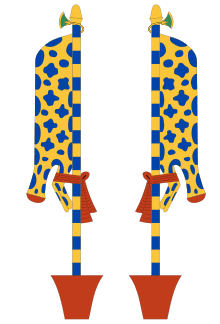Imiut fetish

The Imiut fetish (ỉmỉ-wt) is a religious object that has been documented throughout the history of Ancient Egypt. It was a stuffed, headless animal skin, often of a feline or bull. This fetish was tied by the tail to a pole, terminating in a lotus bud and inserted into a stand. The item was present in ancient Egyptian funerary rites from at least the earliest dynasties. Although its origin and purpose is unknown, the imiut fetish dates as far back as the First Dynasty (3100-2890 BC).
History
In very early Egyptian mythology, the deity Imiut (meaning, "He who is in his wrappings") may have been a god of the Duat or underworld, although insufficient records survive to explain whether this was the case. An early example found in 1914 by an expedition of the Metropolitan Museum of Art near the pyramid of Senusret I (c. 1971-1928 BCE) was placed in a shrine.[1]
Later
Since it was later connected to the god Anubis, it is sometimes called the Anubis fetish. One idea is that it came to symbolise Anubis as an embalmer, although this is unlikely to be the original understanding, as Anubis was originally a god of the dead, rather than just embalming.
Distribution
There are depictions of the imiut fetish on ancient Egyptian temples, and sometimes there were models of it included with the funerary equipment, most notably the two found in the burial chamber of Tutankhamun by Howard Carter.
Notes
- ↑ Edwards, I.E.S. (1972). The Treasures of Tutankhamun. New York: Viking Press. pp. #24. SBN 670-72723-7.